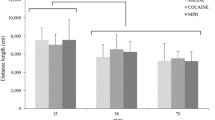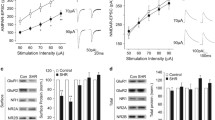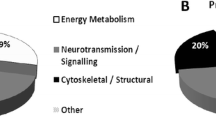Abstract
Attention deficit hyperactivity disorder (ADHD) is a neurodevelopmental disorder characterized by inattention, hyperactivity, and impulsivity symptoms. Neuroimaging studies have revealed a delayed cortical and subcortical development pattern in children diagnosed with ADHD. This study followed up on the development in vitro of frontal cortical neurons from Spontaneously hypertensive rats (SHR), an ADHD rat model, and Wistar-Kyoto rats (WKY), control strain, over their time in culture, and in response to BDNF treatment at two different days in vitro (DIV). These neurons were also evaluated for synaptic proteins, brain-derived neurotrophic factor (BDNF), and related protein levels. Frontal cortical neurons from the ADHD rat model exhibited shorter dendrites and less dendritic branching over their time in culture. While pro- and mature BDNF levels were not altered, the cAMP-response element-binding (CREB) decreased at 1 DIV and SNAP-25 decreased at 5 DIV. Different from control cultures, exogenous BDNF promoted less dendritic branching in neurons from the ADHD model. Our data revealed that neurons from the ADHD model showed decreased levels of an important transcription factor at the beginning of their development, and their delayed outgrowth and maturation had consequences in the levels of SNAP-25 and may be associated with less response to BDNF. These findings provide an alternative tool for studies on synaptic dysfunctions in ADHD. They may also offer a valuable tool for investigating drug effects and new treatment opportunities.





Similar content being viewed by others
Data Availability
Data will be made available from the corresponding author upon reasonable request.
References
Polanczyk GV, Salum GA, Sugaya LS, Caye A, Rohde LA (2015) Annual research review: a meta-analysis of the worldwide prevalence of mental disorders in children and adolescents. J Child Psychol Psychiatry 56(3):345–365. https://doi.org/10.1111/jcpp.12381
Simon V, Czobor P, Bálint S, Mészáros A, Bitter I (2009) Prevalence and correlates of adult attention-deficit hyperactivity disorder: meta-analysis. Br J Psychiatry J Mental Sci 194(3):204–211. https://doi.org/10.1192/bjp.bp.107.048827
American Psychiatric Association (2022) Diagnostic and statistical manual of mental disorders, 5th edn. https://doi.org/10.1176/appi.books.9780890425787
Faraone SV, Biederman J (1998) Neurobiology of attention-deficit hyperactivity disorder. Biol Psychiat 44(10):951–958. https://doi.org/10.1016/s0006-3223(98)00240-6
Fassbender C, Schweitzer JB (2006) Is there evidence for neural compensation in attention deficit hyperactivity disorder? A review of the functional neuroimaging literature. Clin Psychol Rev 26(4):445–465. https://doi.org/10.1016/j.cpr.2006.01.003
Shaw P, Eckstrand K, Sharp W, Blumenthal J, Lerch JP, Greenstein D, Clasen L, Evans A, Giedd J, Rapoport JL (2007) Attention-deficit/hyperactivity disorder is characterized by a delay in cortical maturation. Proc Natl Acad Sci USA 104(49):19649–19654. https://doi.org/10.1073/pnas.0707741104
Cortese S, Kelly C, Chabernaud C, Proal E, Di Martino A, Milham MP, Castellanos FX (2012) Toward systems neuroscience of ADHD: a meta-analysis of 55 fMRI studies. Am J Psychiatry 169(10):1038–1055. https://doi.org/10.1176/appi.ajp.2012.11101521
Eells JB (2003) The control of dopamine neuron development, function and survival: insights from transgenic mice and the relevance to human disease. Curr Med Chem 10(10):857–870. https://doi.org/10.2174/0929867033457700
Meneses A, Perez-Garcia G, Ponce-Lopez T, Tellez R, Gallegos-Cari A, Castillo C (2011) Spontaneously hypertensive rat (SHR) as an animal model for ADHD: a short overview. Rev Neurosci 22(3):365–371. https://doi.org/10.1515/RNS.2011.024
Hoogman M, Bralten J, Hibar DP et al (2017) Subcortical brain volume differences in participants with attention deficit hyperactivity disorder in children and adults: a cross-sectional mega-analysis. Lancet Psychiatry 4(4):310–319. https://doi.org/10.1016/S2215-0366(17)30049-4
Hoogman M, Muetzel R, Guimaraes JP et al (2019) Brain imaging of the cortex in ADHD: a coordinated analysis of large-scale clinical and population-based samples. Am J Psychiatry 176(7):531–542. https://doi.org/10.1176/appi.ajp.2019.18091033
Postema MC, Hoogman M, Ambrosino S et al (2021) Analysis of structural brain asymmetries in attention-deficit/hyperactivity disorder in 39 datasets. J Child Psychol Psychiatry 62(10):1202–1219. https://doi.org/10.1111/jcpp.13396
Norman LJ, Sudre G, Bouyssi-Kobar M, Sharp W, Shaw P (2022) An examination of the relationships between attention/deficit hyperactivity disorder symptoms and functional connectivity over time. Neuropsychopharmacology 47(3):704–710. https://doi.org/10.1038/s41386-021-00958-y
Gálvez JM, Forero DA, Fonseca DJ, Mateus HE, Talero-Gutierrez C, Velez-van-Meerbeke A (2014) Evidence of association between SNAP25 gene and attention deficit hyperactivity disorder in a Latin American sample. Atten Deficit Hyperact Disord 6(1):19–23. https://doi.org/10.1007/s12402-013-0123-9
Gao Q, Liu L, Chen Y, Li H, Yang L, Wang Y, Qian Q (2015) Synaptosome-related (SNARE) genes and their interactions contribute to the susceptibility and working memory of attention-deficit/hyperactivity disorder in males. Prog Neuropsychopharmacol Biol Psychiatry 57:132–139. https://doi.org/10.1016/j.pnpbp.2014.11.001
Faraone SV, Perlis RH, Doyle AE, Smoller JW, Goralnick JJ, Holmgren MA, Sklar P (2005) Molecular genetics of attention-deficit/hyperactivity disorder. Biol Psychiat 57(11):1313–1323. https://doi.org/10.1016/j.biopsych.2004.11.024
Hawi Z, Matthews N, Wagner J, Wallace RH, Butler TJ, Vance A, Kent L, Gill M, Bellgrove MA (2013) DNA variation in the SNAP25 gene confers risk to ADHD and is associated with reduced expression in prefrontal cortex. PLoS ONE 8(4):e60274. https://doi.org/10.1371/journal.pone.0060274
Wilson MC (2000) Coloboma mouse mutant as an animal model of hyperkinesis and attention deficit hyperactivity disorder. Neurosci Biobehav Rev 24(1):51–57. https://doi.org/10.1016/s0149-7634(99)00064-0
Cohen-Cory S, Fraser SE (1995) Effects of brain-derived neurotrophic factor on optic axon branching and remodelling in vivo. Nature 378(6553):192–196. https://doi.org/10.1038/378192a0
McAllister AK, Lo DC, Katz LC (1995) Neurotrophins regulate dendritic growth in developing visual cortex. Neuron 15(4):791–803. https://doi.org/10.1016/0896-6273(95)90171-x
McAllister AK, Katz LC, Lo DC (1999) Neurotrophins and synaptic plasticity. Annu Rev Neurosci 22:295–318. https://doi.org/10.1146/annurev.neuro.22.1.295
Park H, Poo MM (2013) Neurotrophin regulation of neural circuit development and function. Nat Rev Neurosci 14(1):7–23. https://doi.org/10.1038/nrn3379
Liu DY, Shen XM, Yuan FF, Guo OY, Zhong Y, Chen JG, Zhu LQ, Wu J (2015) The physiology of BDNF and its relationship with ADHD. Mol Neurobiol 52(3):1467–1476. https://doi.org/10.1007/s12035-014-8956-6
Shim SH, Hwangbo Y, Yoon HJ, Kwon YJ, Lee HY, Hwang JA, Kim YK (2015) Increased levels of plasma glial-derived neurotrophic factor in children with attention deficit hyperactivity disorder. Nord J Psychiatry 69(7):546–551. https://doi.org/10.3109/08039488.2015.1014834
Jeong HI, Ji ES, Kim SH, Kim TW, Baek SB, Choi SW (2014) Treadmill exercise improves spatial learning ability by enhancing brain-derived neurotrophic factor expression in the attention-deficit/hyperactivity disorder rats. J Exerc Rehabil 10(3):162–167. https://doi.org/10.12965/jer.140111
Nunes F, Pochmann D, Almeida AS, Marques DM, Porciúncula LO (2018) Differential behavioral and biochemical responses to caffeine in male and female rats from a validated model of attention deficit and hyperactivity disorder. Mol Neurobiol 55(11):8486–8498. https://doi.org/10.1007/s12035-018-1000-5
Tsai SJ (2007) Attention-deficit hyperactivity disorder may be associated with decreased central brain-derived neurotrophic factor activity: clinical and therapeutic implications. Med Hypotheses 68(4):896–899. https://doi.org/10.1016/j.mehy.2006.06.025
Hyman C, Hofer M, Barde YA, Juhasz M, Yancopoulos GD, Squinto SP, Lindsay RM (1991) BDNF is a neurotrophic factor for dopaminergic neurons of the substantia nigra. Nature 350(6315):230–232. https://doi.org/10.1038/350230a0
Fumagalli F, Racagni G, Colombo E, Riva MA (2003) BDNF gene expression is reduced in the frontal cortex of dopamine transporter knockout mice. Mol Psychiatry 8(11):898–899. https://doi.org/10.1038/sj.mp.4001370
Alves CB, Almeida AS, Marques DM, Faé AHL, Machado ACL, Oliveira DL, Portela LVC, Porciúncula LO (2020) Caffeine and adenosine A2A receptors rescue neuronal development in vitro of frontal cortical neurons in a rat model of attention deficit and hyperactivity disorder. Neuropharmacology 166:107782. https://doi.org/10.1016/j.neuropharm.2019.107782
Leffa DT, Panzenhagen AC, Salvi AA, Bau CHD, Pires GN, Torres ILS, Rohde LA, Rovaris DL, Grevet EH (2019) Systematic review and meta-analysis of the behavioral effects of methylphenidate in the spontaneously hypertensive rat model of attention-deficit/hyperactivity disorder. Neurosci Biobehav Rev 100:166–179. https://doi.org/10.1016/j.neubiorev.2019.02.019
Kantak KM (2022) Rodent models of attention-deficit hyperactivity disorder: an updated framework for model validation and therapeutic drug discovery. Pharmacol Biochem Behav 216:173378. https://doi.org/10.1016/j.pbb.2022.173378
Sagvolden T (2000) Behavioral validation of the spontaneously hypertensive rat (SHR) as an animal model of attention-deficit/hyperactivity disorder (AD/HD). Neurosci Biobehav Rev 24(1):31–39. https://doi.org/10.1016/s0149-7634(99)00058-5
Yan Y, Eipper BA, Mains RE (2016) Kalirin is required for BDNF-TrkB stimulated neurite outgrowth and branching. Neuropharmacology 107:227–238. https://doi.org/10.1016/j.neuropharm.2016.03.050
Ribeiro FF, Neves-Tomé R, Assaife-Lopes N, Santos TE, Silva RF, Brites D, Ribeiro JA, Sousa MM, Sebastião AM (2016) Axonal elongation and dendritic branching is enhanced by adenosine A2A receptors activation in cerebral cortical neurons. Brain Struct Funct 221(5):2777–2799. https://doi.org/10.1007/s00429-015-1072-1
Cline HT (2001) Dendritic arbor development and synaptogenesis. Curr Opin Neurobiol 11(1):118–126. https://doi.org/10.1016/s0959-4388(00)00182-3
Chen Y, Ghosh A (2005) Regulation of dendritic development by neuronal activity. J Neurobiol 64(1):4–10. https://doi.org/10.1002/neu.20150
Marquèze-Pouey B, Wisden W, Malosio ML, Betz H (1991) Differential expression of synaptophysin and synaptoporin mRNAs in the postnatal rat central nervous system. J Neurosci 11(11):3388–3397. https://doi.org/10.1523/JNEUROSCI.11-11-03388.1991
Kimura K, Mizoguchi A, Ide C (2003) Regulation of growth cone extension by SNARE proteins. J Histochem Cytochem 51(4):429–433. https://doi.org/10.1177/002215540305100404
Osen-Sand A, Staple JK, Naldi E, Schiavo G, Rossetto O, Petitpierre S, Malgaroli A, Montecucco C, Catsicas S (1996) Common and distinct fusion proteins in axonal growth and transmitter release. J Comp Neurol 367(2):222–234. https://doi.org/10.1002/(SICI)1096-9861(19960401)367:2%3c222::AID-CNE5%3e3.0.CO;2-7
Shirasu M, Kimura K, Kataoka M, Takahashi M, Okajima S, Kawaguchi S, Hirasawa Y, Ide C, Mizoguchi A (2000) VAMP-2 promotes neurite elongation and SNAP-25A increases neurite sprouting in PC12 cells. Neurosci Res 37(4):265–275. https://doi.org/10.1016/s0168-0102(00)00125-5
Osen-Sand A, Catsicas M, Staple JK, Jones KA, Ayala G, Knowles J, Grenningloh G, Catsicas S (1993) Inhibition of axonal growth by SNAP-25 antisense oligonucleotides in vitro and in vivo. Nature 364(6436):445–448. https://doi.org/10.1038/364445a0
Chen X, Tomchick DR, Kovrigin E, Araç D, Machius M, Südhof TC, Rizo J (2002) Three-dimensional structure of the complexin/SNARE complex. Neuron 33(3):397–409. https://doi.org/10.1016/s0896-6273(02)00583-4
Li Q, Wong JH, Lu G, Antonio GE, Yeung DK, Ng TB, Forster LE, Yew DT (2009) Gene expression of synaptosomal-associated protein 25 (SNAP-25) in the prefrontal cortex of the spontaneously hypertensive rat (SHR). Biochem Biophys Acta 1792(8):766–776. https://doi.org/10.1016/j.bbadis.2009.05.006
Zhou R, Wang J, Han X, Ma B, Yuan H, Song Y (2019) Baicalin regulates the dopamine system to control the core symptoms of ADHD. Mol Brain 12(1):11. https://doi.org/10.1186/s13041-019-0428-5
Tomasoni R, Repetto D, Morini R, Elia C, Gardoni F, Di Luca M, Turco E, Defilippi P, Matteoli M (2013) SNAP-25 regulates spine formation through postsynaptic binding to p140Cap. Nat Commun 4:2136. https://doi.org/10.1038/ncomms3136
Fortin GD, Desrosiers CC, Yamaguchi N, Trudeau LE (2006) Basal somatodendritic dopamine release requires snare proteins. J Neurochem 96(6):1740–1749. https://doi.org/10.1111/j.1471-4159.2006.03699.x
Landeira BS, Santana TTDS, Araújo JAM, Tabet EI, Tannous BA, Schroeder T, Costa MR (2018) Activity-independent effects of CREB on neuronal survival and differentiation during mouse cerebral cortex development. Cereb Cortex 28(2):538–548. https://doi.org/10.1093/cercor/bhw387
Lonze BE, Ginty DD (2002) Function and regulation of CREB family transcription factors in the nervous system. Neuron 35(4):605–623. https://doi.org/10.1016/s0896-6273(02)00828-0
Aguado F, Díaz-Ruiz C, Parlato R, Martínez A, Carmona MA, Bleckmann S, Ureña JM, Burgaya F, del Río JA, Schütz G, Soriano E (2009) The CREB/CREM transcription factors negatively regulate early synaptogenesis and spontaneous network activity. J Neurosci 29(2):328–333. https://doi.org/10.1523/JNEUROSCI.5252-08.2009
Díaz-Ruiz C, Parlato R, Aguado F, Ureña JM, Burgaya F, Martínez A, Carmona MA, Kreiner G, Bleckmann S, Del Río JA, Schütz G, Soriano E (2008) Regulation of neural migration by the CREB/CREM transcription factors and altered Dab1 levels in CREB/CREM mutants. Mol Cell Neurosci 39(4):519–528. https://doi.org/10.1016/j.mcn.2008.07.019
Mantamadiotis T, Lemberger T, Bleckmann SC, Kern H, Kretz O, Martin Villalba A, Tronche F, Kellendonk C, Gau D, Kapfhammer J, Otto C, Schmid W, Schütz G (2002) Disruption of CREB function in brain leads to neurodegeneration. Nat Genet 31(1):47–54. https://doi.org/10.1038/ng882
Lee R, Kermani P, Teng KK, Hempstead BL (2001) Regulation of cell survival by secreted proneurotrophins. Science 294(5548):1945–1948. https://doi.org/10.1126/science.1065057
Mowla SJ, Farhadi HF, Pareek S, Atwal JK, Morris SJ, Seidah NG, Murphy RA (2001) Biosynthesis and post-translational processing of the precursor to brain-derived neurotrophic factor. J Biol Chem 276(16):12660–12666. https://doi.org/10.1074/jbc.M008104200
Pang PT, Teng HK, Zaitsev E, Woo NT, Sakata K, Zhen S, Teng KK, Yung WH, Hempstead BL, Lu B (2004) Cleavage of proBDNF by tPA/plasmin is essential for long-term hippocampal plasticity. Science 306(5695):487–491. https://doi.org/10.1126/science.1100135
Autry AE, Monteggia LM (2012) Brain-derived neurotrophic factor and neuropsychiatric disorders. Pharmacol Rev 64(2):238–258. https://doi.org/10.1124/pr.111.005108
Corominas-Roso M, Ramos-Quiroga JA, Ribases M, Sanchez-Mora C, Palomar G, Valero S, Bosch R, Casas M (2013) Decreased serum levels of brain-derived neurotrophic factor in adults with attention-deficit hyperactivity disorder. Int J Neuropsychopharmacol 16(6):1267–1275. https://doi.org/10.1017/S1461145712001629
Yang J, Siao CJ, Nagappan G, Marinic T, Jing D, McGrath K, Chen ZY, Mark W, Tessarollo L, Lee FS, Lu B, Hempstead BL (2009) Neuronal release of proBDNF. Nat Neurosci 12(2):113–115. https://doi.org/10.1038/nn.2244
Yang J, Harte-Hargrove LC, Siao CJ, Marinic T, Clarke R, Ma Q, Jing D, Lafrancois JJ, Bath KG, Mark W, Ballon D, Lee FS, Scharfman HE, Hempstead BL (2014) proBDNF negatively regulates neuronal remodeling, synaptic transmission, and synaptic plasticity in hippocampus. Cell Rep 7(3):796–806. https://doi.org/10.1016/j.celrep.2014.03.040
Woo NH, Teng HK, Siao CJ, Chiaruttini C, Pang PT, Milner TA, Hempstead BL, Lu B (2005) Activation of p75NTR by proBDNF facilitates hippocampal long-term depression. Nat Neurosci 8(8):1069–1077. https://doi.org/10.1038/nn1510
McAllister AK (2000) Cellular and molecular mechanisms of dendrite growth. Cereb Cortex 10(10):963–973. https://doi.org/10.1093/cercor/10.10.963
Huang EJ, Reichardt LF (2001) Neurotrophins: roles in neuronal development and function. Annu Rev Neurosci 24:677–736. https://doi.org/10.1146/annurev.neuro.24.1.677
Takemoto-Kimura S, Ageta-Ishihara N, Nonaka M, Adachi-Morishima A, Mano T, Okamura M, Fujii H, Fuse T, Hoshino M, Suzuki S, Kojima M, Mishina M, Okuno H, Bito H (2007) Regulation of dendritogenesis via a lipid-raft-associated Ca2+/calmodulin-dependent protein kinase CLICK-III/CaMKIgamma. Neuron 54(5):755–770. https://doi.org/10.1016/j.neuron.2007.05.021
Ravindran S, Nalavadi VC, Muddashetty RS (2019) BDNF induced translation of limk1 in developing neurons regulates dendrite growth by fine-tuning cofilin1 activity. Front Mol Neurosci 12:64. https://doi.org/10.3389/fnmol.2019.00064
Dijkhuizen PA, Ghosh A (2005) BDNF regulates primary dendrite formation in cortical neurons via the PI3-kinase and MAP kinase signaling pathways. J Neurobiol 62(2):278–288. https://doi.org/10.1002/neu.20100
Kulkarni VA, Firestein BL (2012) The dendritic tree and brain disorders. Mol Cell Neurosci 50(1):10–20. https://doi.org/10.1016/j.mcn.2012.03.005
Yuste R (2015) From the neuron doctrine to neural networks. Nat Rev Neurosci 16(8):487–497. https://doi.org/10.1038/nrn3962
Acknowledgements
This work was supported by grants from Brazilian agencies (CNPq, CAPES) and FAPERGS. The CAPES fellowship supported DMM and MVSL. ASA and CBAO were a recipient of the CNPq fellowship. ACLM was supported by the PIBIC—UFRGS (CNPq) fellowship.
Funding
This research was supported by Conselho Nacional de Desenvolvimento Científico e Tecnológico (CNPq), Coordenação de Aperfeiçoamento de Pessoal de Nível Superior (CAPES-FCT), Programa de Apoio aos Núcleos de Excelência (PRONEX/FAPERGS), Fundação de Apoio à Pesquisa do Estado do Rio Grande do Sul (FAPERGS).
Author information
Authors and Affiliations
Contributions
DMM and LOP conceived and designed the study. DMM, ASA, CBAO, MVSL and ACLM performed all experiments. DMM and LOP performed statistical analysis. LOP and DMM interpreted data, wrote, prepared figures, and revised the manuscript. LOP coordinated the study. All authors revised and contributed to the final version of this manuscript.
Corresponding author
Ethics declarations
Conflict of Interest
The authors declare no competing interests.
Ethical approval
All experimental protocols were approved by the ethical committee of the Federal University of Rio Grande do Sul and all procedures in this study followed the rules of the NIH Guide for Care and Use of Laboratory Animals as well as the Brazilian Society for Neuroscience and Behavior (SBNeC) recommendations for animal care.
Additional information
Publisher's Note
Springer Nature remains neutral with regard to jurisdictional claims in published maps and institutional affiliations.
Rights and permissions
Springer Nature or its licensor (e.g. a society or other partner) holds exclusive rights to this article under a publishing agreement with the author(s) or other rightsholder(s); author self-archiving of the accepted manuscript version of this article is solely governed by the terms of such publishing agreement and applicable law.
About this article
Cite this article
Marques, D.M., Almeida, A.S., Oliveira, C.B.A. et al. Delayed Outgrowth in Response to the BDNF and Altered Synaptic Proteins in Neurons From SHR Rats. Neurochem Res 48, 2424–2435 (2023). https://doi.org/10.1007/s11064-023-03917-9
Received:
Revised:
Accepted:
Published:
Issue Date:
DOI: https://doi.org/10.1007/s11064-023-03917-9




